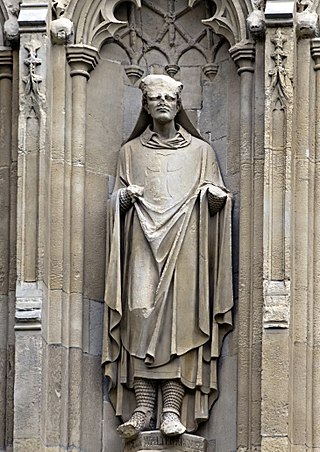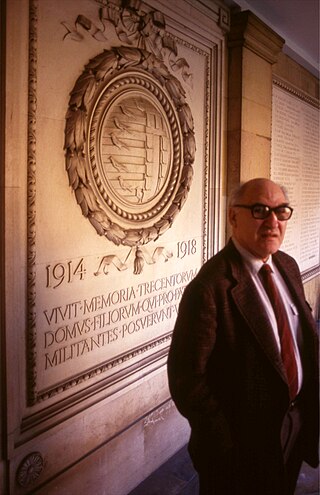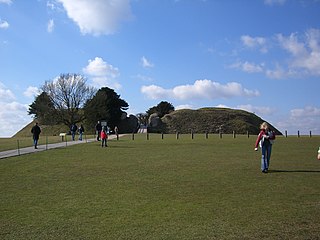
Hubert Walter was an influential royal adviser in the late twelfth and early thirteenth centuries in the positions of Chief Justiciar of England, Archbishop of Canterbury, and Lord Chancellor. As chancellor, Walter began the keeping of the Charter Roll, a record of all charters issued by the chancery. Walter was not noted for his holiness in life or learning, but historians have judged him one of the most outstanding government ministers in English history.

In the civil service of the United Kingdom, His Majesty's Exchequer, or just the Exchequer, is the accounting process of central government and the government's current account in the Consolidated Fund. The term is used in various financial documents, including the latest departmental and agency annual accounts.

Gerhard "George" Lachmann Mosse was a German-American social and cultural historian, who emigrated from Nazi Germany to Great Britain and then to the United States. He was professor of history at the University of Iowa, the University of Wisconsin–Madison, and also in Israel, at the Hebrew University of Jerusalem. Best known for his studies of Nazism, he authored more than 25 books on topics as diverse as constitutional history, Protestant theology, and the history of masculinity. In 1966, he and Walter Laqueur founded The Journal of Contemporary History, which they co-edited.
Chief Rabbi is a title given in several countries to the recognized religious leader of that country's Jewish community, or to a rabbinic leader appointed by the local secular authorities. Since 1911, through a capitulation by Ben-Zion Meir Hai Uziel, Israel has had two chief rabbis, one Ashkenazi and one Sephardi.

The history of the Jews in England goes back to the reign of William the Conqueror. Although it is likely that there had been some Jewish presence in the Roman period, there is no definitive evidence, and no reason to suppose that there was any community during Anglo-Saxon times. The first written record of Jewish settlement in England dates from 1070. The Jewish settlement continued until King Edward I's Edict of Expulsion in 1290.

The first Jews in England arrived after the Norman Conquest of the country by William the Conqueror in 1066, and the first written record of Jewish settlement in England dates from 1070. Jews suffered massacres in 1189–90, and after a period of rising persecution, all Jews were expelled from England after the Edict of Expulsion in 1290.

Emilia Lanier was the first woman in England to assert herself as a professional poet, through her volume Salve Deus Rex Judaeorum. Attempts have been made to equate her with Shakespeare's "Dark Lady".
Isaac of Norwich or Isaac ben Eliav was a Jewish-English financier of the twelfth and thirteenth centuries. He was among the Jews imprisoned by King John of England in 1210. It is possible that at this time a house of his in London fell into the hands of the king and was afterward (1214) transferred to the Earl of Derby. He was by far the most important Jewish moneylender at Norwich in the early years of Henry II; the majority of the items in a daybook of that place now preserved at Westminster Abbey refer to his transactions. In the "Shetarot" Isaac is referred to as "Nadib" or "Mæcenas". He appears to have died before 1247. A caricature of him appears in an issue of the Exchequer, 17, Hen. III. (1233), which represents him as being tortured by a demon and expresses the contemporary Christian view of his rapaciousness. The accompanying caricature represents Isaac as three-faced, probably in allusion to the wide extent of his dealings. He is depicted wearing a crown and observing a scene where two other Jews, Mosse Mok and a woman named Abigail, are being tortured by demons, apparently under his supervision. The scene has been suggested to be similar to a miracle play, with the drapery representing the stage and the architectural adornment the cloister of a church; such plays are generally performed in churches; however, it is likely that the scene is the Tower of London, where Jews were imprisoned and tried. The document, which was on display in the 2019 museum exhibition Jews, Money, and Myth, is said to be the world's oldest antisemitic caricature.
Hagin ben Moses or Hagin filus Mossy was Presbyter Judaeorum or Chief Rabbi of the Jews of England and agent of Richard of Cornwall, who was King of the Romans. He appears to have been the chirographer of the Jews of London and obtained great wealth, but he lost it under Edward Longshanks, King of England.
Jacob of London was the first known Presbyter Judaeorum of the Jews of England; appointed to that position by King John in 1199, who also gave him a safe-conduct. He appears to have died in 1217, when Josce of London is mentioned as his successor. He is possibly identical with the rabbi Jacob of London who translated the whole Haggadah into the vernacular so that women and children could understand it.
Elias of London also known as Elijah ben Moses or Elias le Evesque, was Presbyter Judaeorum in 13th-century England.
Aaron of York or Aaron fil Josce, was a Jewish financier and chief rabbi of England. He was born in York before 1190 and died after 1253. He was probably the son of Josce of York, the leading figure in the York pogrom of 1190.
The Jewish Hungarian family of Mendel is the name of a prominent Hungarian family which flourished in the latter half of the 15th century and in the first half of the 16th in Ofen (Buda). Members of three generations of it are known; namely, Jacob, Israel, and Isaac Mendel, who held the office of "Princeps Judæorum", "Supremus Judæorum," or "Præfectus Judæorum" between 1482 and 1539. This office, which seems to have existed only during that period, was created by King Matthias Corvinus in order to give the Jews an accredited representative at court, who at the same time should be responsible for the payment of their taxes. The "Præfectus Judæorum" was empowered to impose fines and other penalties on the Jews. As an official of the crown he was exempted from wearing the Jewish hat.
The Exchequer of the Jews was a division of the Court of Exchequer at Westminster which recorded and regulated the taxes and the law-cases of the Jews in England and Wales. It operated from the late 1190s until the eventual expulsion of the Jews in 1290.
Josce of London was an English Jew and the Presbyter Judaeorum, or Chief Rabbi, of the Jews of England from 1217 to 1237.

Berechiah de Nicole also known as Benedict fil Mosse,, was a thirteenth-century English Tosafist who lived at Lincoln.

Hugh Bardulf or Hugh Bardolf was a medieval English administrator and royal justice. Known for his legal expertise, he also served as a financial administrator. He served three kings of England before his death.
William de Warenne, the feudal baron of Wormegay, served as a royal justice under King Richard I and his brother King John. Warenne also served in financial matters, being one of those responsible for collecting taxes and later overseeing debts from Christians to Jews. His career was closely tied to that of Hubert Walter, who employed Warenne as a judge in some ecclesiastical matters. He also founded a priory and gave other gifts to religious houses. The historian Ralph V. Turner said of Warenne that "although he was a longtime official under King John, he did not quite fit into the inner corps of royal counselors".
Hagin fil Deulacres was a 13th-century rabbi who served as the last Presbyter Judaeorum of England prior to the Edict of Expulsion of 1290. A Jew from London, Hagin was appointed to the position on 15 May 1281, through the intercession of Queen Eleanor of Provence. His is not mentioned among the Jewish deportees, and is therefore presumed to have died before the Expulsion.
Eliyahu Menachem of London (1220-1284) was a rabbi and communal leader in 13th-century England.









